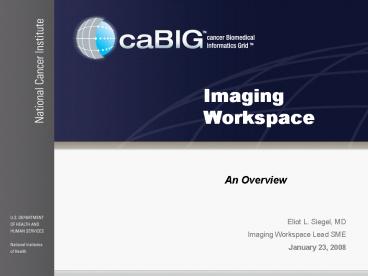Imaging Workspace PowerPoint PPT Presentation
1 / 22
Title: Imaging Workspace
1
Imaging Workspace
- An Overview
Eliot L. Siegel, MD Imaging Workspace Lead
SME January 23, 2008
2
Introduction
- Imaging has been separate island with its own
standards (DICOM) - DICOM allows high level of interoperability among
clinical imaging modalities such as CT and MRI - Patient centered and very limited for data mining
and research - Completely separate from world of XML, service
oriented architecture, Grid Computing - Different vendors algorithms provide different
results with no standards for annotation and
image mark-up
3
Goals of the Imaging Workspace
The In Vivo Imaging Workspace was added to the
caBIG program in April of 2005 1. To advance
imaging informatics for treatment of patients
with cancer. 2. Leverage the caBIG technology
to share images in a variety of settings. 3.
Strive towards a standardized way to evaluate
tumor change. 4. Facilitate secure and easy
sharing of images within the cancer community.
4
National Cancer Imaging Archive
The NCIA network-accessible "in vivo image
repository" provides image archives to assist
development and validation of imaging software
tools Multiple image libraries currently stored
on archive including LIDC Not only repository,
but software for NCIA is free and open
source Federated system so single inquiry can
produce responses from multiple
repositories Includes visualization tool
5
What are the Imaging Workspace Products?
6
eXtensible Imaging Platform (XIP) Allows Easy
Sharing of Image Enhancement/Analysis/Visualizatio
n Algorithms
Medical Imaging Workstation
XIP Application Builder
XIP Application
XIP Modules Host Independent
Distribute
XIP Host Adapter
XIP LIB
ITK
VTK
. . .
Web-based Application
Distribute
WG23
WG23
WG23
WG23
XIP Host
(Can be replaced with any DICOM WG23-compatible
Host)
Host-Specific Plug-in Libs
DICOM, HL7, otherservices per IHE
caGRID Services viaImaging Middleware
Distribute
A free and open source platform that facilitates
the sharing not of images and other patient data
but of image display, processing, and analysis
algorithms themselves.
Standalone Application
XIP Class Library Auto Conversion Tool
7
Imaging Middleware (including GridCAD and
Virtual PACS)
Middleware provides connection between DICOM and
Grid computing The GRID has tremendous potential
to promote interoperability, improve security,
and support more efficient sharing of image data
and software algorithms Middleware projects such
as CAD (computer aided detection) for lung
nodules on CT scans demonstrate the power and
potential of GRID computing
8
Annotations and Imaging Markup (AIM)
The first project of its kind that were aware of
to propose/create a standard means of adding
information/knowledge to an image in a clinical
environment in which there is currently chaos in
order to create a future in which image content
can be easily and automatically searched.
9
Algorithm Validation Tools (AVT)
BaselineMax Diameter 36.2mmVolume 6.1cm3
Baseline 20 weeksMax Diameter 32.6mmVolume
9.48cm3 55 increase
10
DICOM Ontology
A single common reference information model for
DICOM Unify and make explicit all the key
entities and relations in DICOM in a human-usable
but machine-processable format. Represent the
existing DICOM model, whether it be implicit or
explicit, as an ontology.
11
Query Formulation
Create an Imaging Query Formulation
tool Automates the creation of ontology-based
queries to image resources
Query Formulation Engine will translate user
queries that are formulated using the QueryTool
UI into an ontology-based query graph.
12
Imaging Workspace and DSIC
- Imaging has similar challenges to other
workspaces with regards to data sharing and
intellectual capital - Culture of sharing information
- IRB approval
- IT local policies for security/privacy including
HIPAA challenges - Unique face challenge for diagnostic images
- Can images of the face be de-identified?
- Dan Steinberg lecture at first face to face threw
down the gauntlet
13
1
2
3
6
4
5
14
Major Implications Types of Studies
- CT studies
- Maxillofacial sinuses
- Cerebral vasculature
- Brain
- Face
- Head
- MRI studies
15
Use Cases for De-Identified Files
- 3D multi-planar reconstruction (MPR)
- Clinical diagnosis
- Clinical trials
- Research repositories
- Therapeutic planning
- Teaching
- Teaching files
- Clinical decision support
16
The Study
- Are 3D facial reconstructed images the same as
full face photographic images? - IRB approved, prospective
- Informed consents were obtained for all digital
photos and 3D images
17
The Study
- 179 participants enrolled
- 29 digital photos and 3D images of face
- 150 digital photos of face only
- 105 image reviewers
18
(No Transcript)
19
Accuracy Results
- Overall accuracy 60.4
- Correct photo present accuracy 72.9
- No correct photo accuracy 47.9 (p lt 0.001)
- Association with age
- Younger image reviewers were less accurate
- No association
- gender
- ethnicity
- Occupation
20
Discussion
- Results are surprisingly poor
- Not accustomed to the 3D facial reconstructed
images - No facial hair, scalp hair, eyebrows
- Gravity on facial features
- No distinguishing hair, eye, skin color
- No time limit
- Varying body habitus, sex, age, ethnicity
- Matching photographs are along side of the 3D
images - Same background
- Face perception - complex and not well understood
21
Future Work
- MRI Defacer (www.nbirn.net)
22
In The Near Future Practical Applications of
Workspace Tools
Open Source Imaging Viewer
Clinical Trials Tool Integration
Other Adoption Activities

